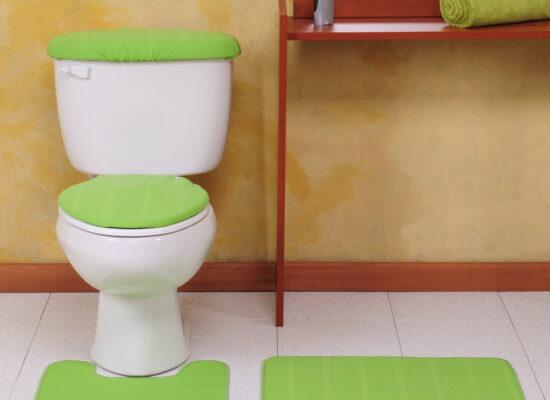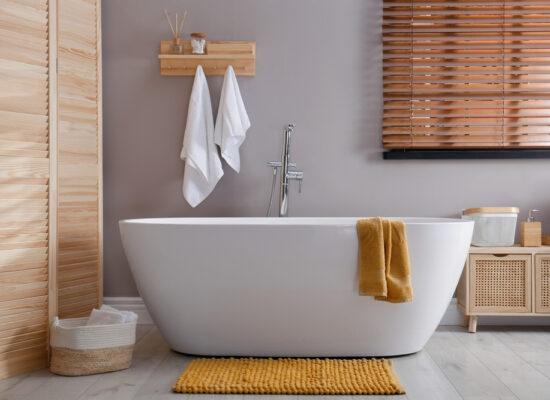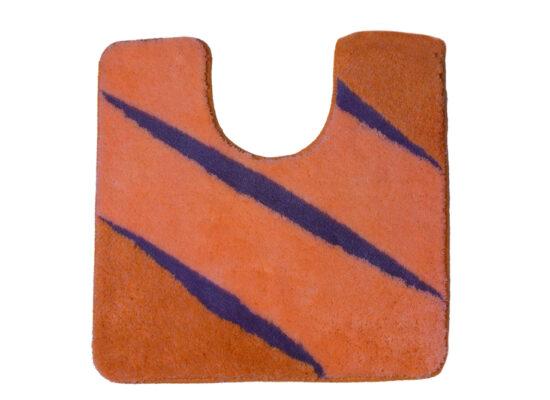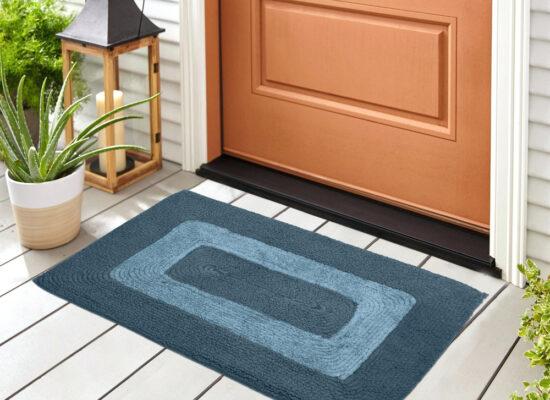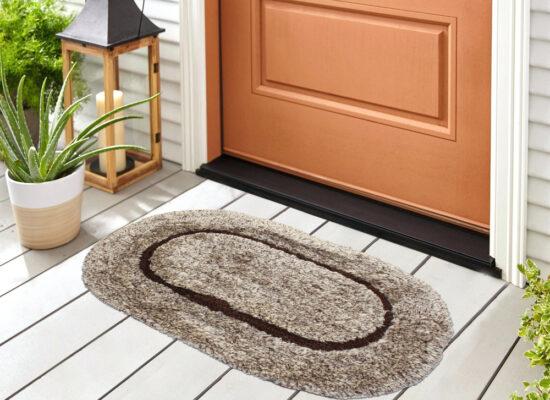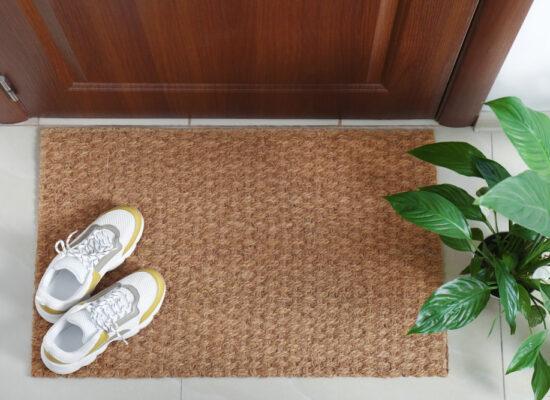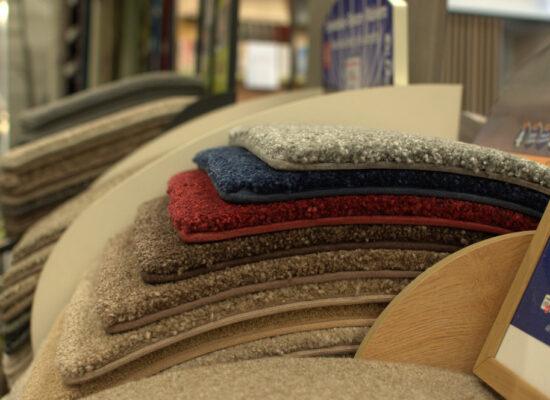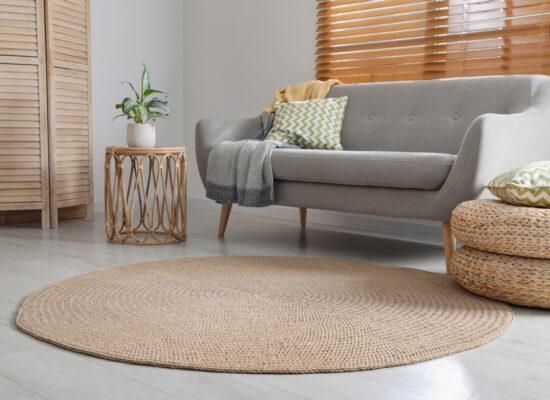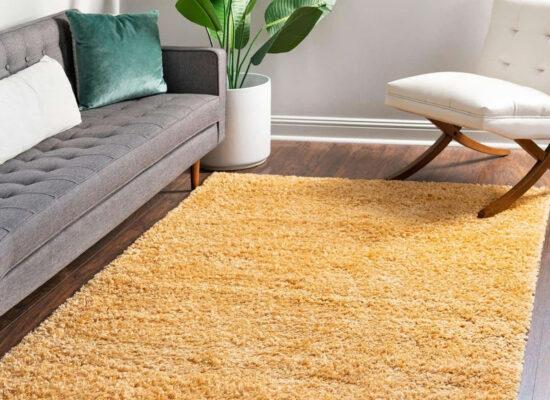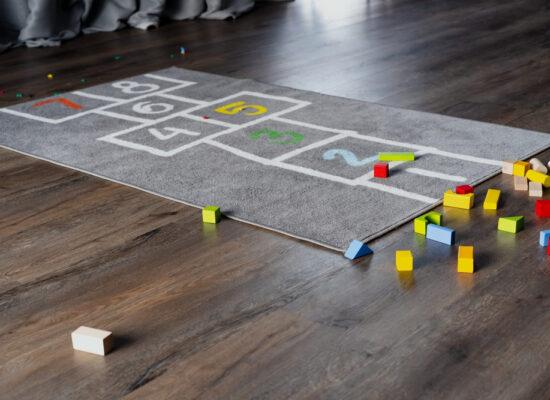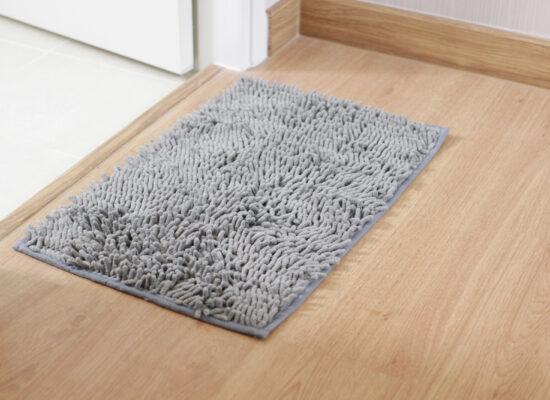Bath mat
In order to pamper bare feet with a soft pile and to capture the final drops of water, bathmats are typically put in front of the shower or bathtub. A bath mat is constructed of a material that is far more absorbent than a typical carpet runner and is appropriate for moist environments. Additionally, bathroom carpets are very fluffy and attractive, and they look excellent in hotels or your personal spa area. You can select a coordinated set of bath, toilet, wash basin, and toilet cover rugs in addition to a single mat.
The majority of bathroom rugs feature an anti-slip layer on the underside, which makes sure the mat remains in place. Make sure the mat is appropriate for your bathroom’s underfloor heating if it has that feature. If not, the heat could cause the coating to gradually peel off over time.
Fiber, cotton, or synthetics?
Bath mats are made of this, and their pile heights range from 5 to 50 mm. Numerous versions additionally provide the total weight, allowing conclusions to be made regarding the thickness of the material. The mat is often warmer and softer the more tightly the fabric is woven and the greater the pile. However, when purchasing rugs, our clients typically pay close attention to the benefits of the material and how it was made.
Good for the indoor climate is pure cotton.
Pure cotton bath mats are excellent for your skin. Large volumes of moisture as well as dirt can be easily absorbed by the material and released again. Cotton bath mats are easily cleaned with routine vacuuming, washing, or dry cleaning. Cotton is incredibly strong and breathable, like the majority of natural fibers, which means that it improves the indoor environment. As an environmentally friendly alternative, models made of organic cotton can go well with your bathroom items.
Synthetic Fiber: Vibrant, Durable Colors
Soft and dimensionally stable synthetic fibers like polyester or polyacrylic microfiber stand out in this category. The material is extremely lightfast and colorfast in addition to being durable and abrasion-resistant. Luminous hues endure for a very long period.
Doormats
Door mats serve a very vital purpose in addition to serving as a warm invitation to enter a space. A door mat effectively prevents potential dangers from reaching the inner floor space by scraping dirt, trash, and surplus moisture from foot traffic entering a home or office. In actuality, 90% of the dirt that is brought into a business is brought in on the shoes of the customers. Door mats significantly reduce the risk of slip and fall accidents while also reducing the amount of labor needed to maintain a facility.
You might want to rethink your position if you believe that safety risks are not anything to be concerned about. If you are a business owner thinking about installing door mats on your property, you need to be familiar with these guidelines as slip and fall accidents make up the vast majority of small business insurance claims. These rules specify how mats should be put, used, and maintained as well as the potential repercussions of doing any incorrectly. Even if you are trying to choose a door mat for your own personal use, it is a good idea to learn about the options available for mats so you can get a high-quality mat that lasts longer than its large box store counterparts and may even help you avoid filing claims with your homeowner’s insurance.
What Makes Door Mats Necessary?
A door mat is a common and essential way for you to maintain your building safe and tidy in addition to being a terrific way to welcome customers into your institution and add to the design of your business. Here are three justifications for employing a door mat:
1. A doormat covers a potentially dangerous region. The majority of slip and fall incidents happen close to entrance and exit points. This can be because of how much dirt and moisture people track inside buildings, or it might be because customers come and go from your store quickly. In any case, using a door mat is necessary due to the chance of a slip and fall near your entry.A mat should be positioned both outside and inside your door to reduce risk the greatest. The interior mat can just be a “wiper” styled mat if the door mat outside your business is a “wiper-scraper” mat.The texture and purpose of the mat surface distinguishes these two mat designs. The rougher, harder tread of a wiper-scraper efficiently wipes and scrapes dirt from the bottoms of shoes. The tread of a wiper is a little less harsh.
2. Less internal debris and dirt tracking As already indicated, the amount of dirt entering your building can be reduced by up to 90% by using the right door mats. This is important even if you are just buying a door mat for your house. By placing adequate door mats to catch and trap dirt and debris commonly dragged in by foot traffic, you’ll save yourself and your team a lot of extra time you’d otherwise spend cleaning, vacuuming, and mopping. Additionally, this soil trapping keeps any dangers outside of your building. The likelihood of dirt and moisture being tracked into an interior space is significantly increased when door mats are not used at a building’s or home’s entry.These wet or slick spots present hazards that invite slip, trip, and fall incidents.
3. Appeal to the eye. Without mentioning the use of lovely door mats, every establishment’s entrance is made to feel pleasant. A high-quality, aesthetically pleasing mat that can hold dirt and moisture without seeming dirty will help you as a business owner make a good first impression. As a homeowner, a door mat is practically required and fosters a welcoming environment that makes a visitor feel appreciated, at ease, and certain that they won’t track messes inside your home.
Which Material Makes the Best Door Mats?
A door mat can be created by any producer. It has a very straightforward design and an uncomplicated manufacturing process. However, there are other factors to take into account when creating a door mat that is both attractive and secure. It takes engineering expertise to create features like beveled edges, sunken water dams, and high-traction backings—features you wouldn’t typically associate with door mats. In light of this, the following advice is provided on the components your mat is made of: Rubber undersides. Rubber is the accepted material for door mat backing. Nothing holds up better to testing against all types of flooring than rubber.Your door mat backing should be constructed entirely of rubber components, whether you decide to go with a recycled rubber backed product or a Nitrile rubber (more resistant to oil and grease than other types of rubber).
For use on different types of flooring, door mats can have various backings that prevent them from slipping. For example, some door mats include cleated backings for use on carpeted surfaces. In addition to giving your house and company a pleasant appearance, using door mats properly drastically minimizes the quantity of dirt tracked into your institution and lowers the danger of slip and fall accidents. Based on the amount of foot traffic, potential risks, and inside and outside door mat needs, you should choose door mats. There are several possibilities for door mats in terms of size, color, and material.
